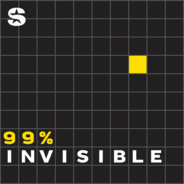What we see on screen has this way of influencing our perception of the world, which makes sense because the average American spends 2 hours and 51 minutes watching movies and TV each day. That’s a whopping 19 percent of our waking hours. Walt Hickey is a data journalist and author of a new book called You Are What You Watch. In it, Walt makes a case for how much film and television shapes us as individuals and as a society, far beyond what we give it credit for.You Are What You Watch
Subscribe to SiriusXM Podcasts+ to listen to new episodes of 99% Invisible ad-free and a whole week early. Start a free trial now on Apple Podcasts or by visiting siriusxm.com/podcastsplus.

Kultur & GesellschaftWissenschaft & Technik
99% Invisible Folgen
Design is everywhere in our lives, perhaps most importantly in the places where we've just stopped noticing. 99% Invisible is a weekly exploration of the process and power of design and architecture. From award winning producer Roman Mars. Learn more at 99percentinvisible.org.
Folgen von 99% Invisible
739 Folgen
-
Folge vom 21.02.2024You Are What You Watch
-
Folge vom 16.02.2024The Power Broker #2: Jamelle BouieThis is the second official episode, breaking down the 1974 Pulitzer Prize winning book, The Power Broker by our hero Robert Caro.This week, Roman Mars and Elliott Kalan sit down with New York Times political columnist Jamelle Bouie as our book club guest.Elliott and Roman cover Part 3 of the book (Chapter 6 through Chapter 10), discussing the major story beats and themes, with occasional asides from Jamelle Bouie guiding us through the politics of the era.The Power Broker #02: Jamelle BouieJoin the discussion on Discord and Reddit. Subscribe to SiriusXM Podcasts+ to listen to new episodes of 99% Invisible ad-free and a whole week early. Start a free trial now on Apple Podcasts or by visiting siriusxm.com/podcastsplus.
-
Folge vom 13.02.2024The White Castle System of Eating HousesWhite Castle has its own take on fast food hamburgers. For starters, the patties are square, with five holes in each patty. And they’re small, too –- two-and-a-half inch sliders. Just big enough to fit into the palm of your hand. And since they’re steamed on a bed of onions, everything is infused with this very specific onion-esque flavor.Today, White Castles can be hard to find, depending on where you live. But KCUR's Mackenzie Martin, a producer at A People's History of Kansas City, says that it’s time to stop thinking of White Castle as a semi-obscure cultural punchline, because over a century ago, White Castle invented something that became so important and all-encompassing that, today, it touches pretty much every person in America. Sometimes several times a day. Something that, in other countries, has almost come to define American culture: it has a strong claim to being the first fast-food restaurant.The White Castle System of Eating Houses Subscribe to SiriusXM Podcasts+ to listen to new episodes of 99% Invisible ad-free and a whole week early. Start a free trial now on Apple Podcasts or by visiting siriusxm.com/podcastsplus.
-
Folge vom 06.02.2024Between the BlocksSeen from above, Sofia, Bulgaria, looks less like a city and more like a forest. Large "interblock park" green spaces between big apartment structures are a defining characteristic of the city. They're not so much "parks" in the formal sense, with fences and gates, just open green areas growing up in interstitial spaces left behind.But as green as it still looks today, Sofia used to be even greener. Since the fall of Bulgarian communism in the late 1980s, Sofia has lost more than half of its green space. To understand why, one has to look back to how the city evolved and grew in the Soviet era.Between the Blocks Subscribe to SiriusXM Podcasts+ to listen to new episodes of 99% Invisible ad-free and a whole week early. Start a free trial now on Apple Podcasts or by visiting siriusxm.com/podcastsplus.
